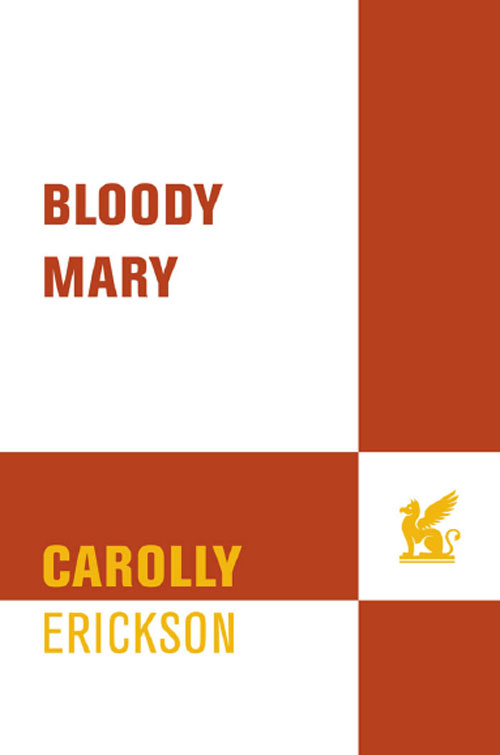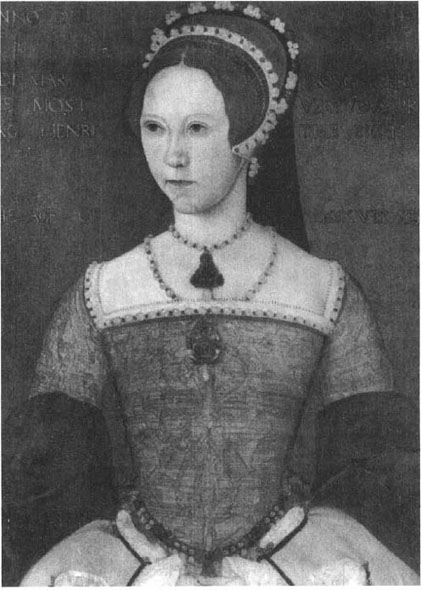Bloody Mary
Authors: Carolly Erickson


BLOODY MARY
A
LSO BY
C
AROLLY
E
RICKSON
The Records of Medieval Europe
Civilization and Society in the West
The Medieval Vision
Mistress Anne
Great Harry
The First Elizabeth
Our Tempestuous Day
Bonnie Prince Charlie
To the Scaffold: The Life of Marie Antoinette
Her Little Majesty
Great Catherine
BLOODY MARY

CAROLLY ERICKSON

St. Martin’s Griffin New York
New York
BLOODY MARY.
Copyright © 1978 by Carolly Erickson. All rights reserved. Printed in the United States of America. No part of this book may be used or reproduced in any manner whatsoever without written permission except in the case of brief quot ations embodied in critical articles or reviews. For information, address St. Martin’s Press, 175 Fifth Avenue, New York, N.Y. 10010.
Library of Congress Cataloging-in-Publication Data
Erickson, Carolly.
Bloody Mary / Carolly Erickson
p. cm.
Originally published: Garden City, N.Y. :
Doubleday, 1978.
Includes bibliographical references and index.
ISBN 0-312-18706-8
1. Mary I, Queen of England, 1516-1558. 2. Great Britain—History—Mary I, Queen of England, 1553-1558. 3. Queens—Great Britain—Biography. I. Title.
[DA347.E74 1998]
942.05'4'092'dc21
[b] | 98-16069 |
First published in the United States by Doubleday & Company, Inc.
10 9 8 7 6 5
To Peter

1. The Princess Mary at twenty-eight, in 1544, by Master John (Johannes Corvus).
NATIONAL PORTRAIT GALLERY, LONDON
.
W
HEN
I learned, in the spring of 1995, that St. Martin’s Press wanted to reissue my four Tudor biographies I was delighted, and grateful to the editor, Charles Spicer, for sponsoring the project—and at the same time a bit dismayed. For I was told there would have to be a new preface to the four books, and the thought of writing such a preface seemed daunting.
My first thought was that I would need to reacquaint myself with all the significant books and articles that had been written on Mary Tudor, Henry VIII, Elizabeth I, and Anne Boleyn over the past dozen years or so and hold my earlier work up to the scrutiny of more recent research. But in fact I have been reading, and reviewing, these books (I have not read all the articles) as they came out and am familiar with the state of Tudor scholarship, and by and large, there have been no upheavals in interpretive viewpoint, no exciting documentary finds of wide import, no fundamental shifts in historical understanding—apart from the lamentable influence of political correctness that continues to corrode academic investigation—that make my biographies obsolete.
Bloody Mary, Great Harry, Fair Eliza
(published as
First Elizabeth),
and
Mistress Anne
were written, in that order, between the fall of 1975 and the fall of 1983. Each was contracted for separately; had I known, when I began
Bloody Mary,
that I would be writing biographies of the other three historical figures I would have designed my research quite differently. I knew that I would be writing for what is called a “popular audience”—a catchall term that includes readers of widely differing educational backgrounds and tastes, united by a thirst for reexperienc
ing the past through the pages of a readable story. My emphasis was on storytelling, but storytelling deeply anchored in the historical sources and faithful to those sources not only in detail and tone but in emphasis; I did not want to take what was familiar or coherent to twentieth-century readers and leave the rest—often the heart of any given text—in obscurity.
Bloody Mary
found its audience, and the biographical philosophy I developed while writing that book has governed my approach to historical biography ever since. Simply stated, that philosophy is as follows: I pay as much or more attention to the inner life (drives, motivations, emotions, attitudes, character) as to the outer. I try to preserve the natural arc of the life as my subject lived it, allotting as much or more space to the earlier years (whether or not they were the years of fame or Historically Significant Incident) as to the later ones. I never invent dialogue; every word attributed to a historical character in my biographies is a direct quote from a contemporary source—although, as anyone who has done historical research knows, contemporary sources are far from being exact reflections of truth and contain their own distortions. (When I attribute an emotion or attitude to a character, that too is based on hints or explicit statements in contemporary sources, not on speculation.) I try to tell the story as if the outcome were unknown, as if many alternate futures were possible—as they were, in the thinking of my subjects, while they were living out their lives.
Most important, I try to discover and stress those elements in the story that point to differences between past and present. The sixteenth century was a profoundly different time than our own era, with different prevailing assumptions about reality, human nature, and the place of men and women in the great hierarchy that was thought to link all life to the divine. Life was believed, accurately, to be short and beset with dangers. Clues to its course were provided on all sides by the supernatural world, hence the eager curiosity (and dread) of Tudor folk for all manner of signs and wonders—comets, freaks of nature, prophecies, messages (however spurious) from the beyond.
Thus when a “marvelous fish” ninety feet long was found beached on the English coast in 1532, crowds gathered to wonder at it and were in no doubt that it was a dark portent; Henry VIII and Anne Boleyn
were then making the crossing to France, and the fish was believed to be a warning that no good would come of their journey.
Because the subjects of my biographies bear famous names, they evoke in the minds of readers conventional images, images heavily colored by cinematic or other fictional melodrama. The Henry VIII I write about in
Great Harry
is far different from the coarse and bloated lecher of dramatic cliche; he is a brilliant, athletic, heroic figure bursting with vigor who, when he encountered unconscionable dynastic obstacles, shrugged off the restraints by which he felt himself unjustly bound and muscled his way to an ill-fated independence. Late in life, he became monstrous, inwardly and outwardly, but his ugly metamorphosis was a long time coming. Similarly, the Anne Boleyn described in
Mistress Anne
is not the sympathetic heroine victimized by a ferocious and brutal husband, but a prideful young woman exploited by those around her, a somewhat enigmatic figure at the heart of a dark fairy tale, ultimately pulled down into the quicksand of court politics, her pride broken.
My Tudor biographies were written at a time when the insights of feminism were beginning to leaven the writing of history. Before the 1970s, biographies of female historical figures had more often than not been distorted by antifeminist stereotypes; now a new generation of writers was attempting to set aside these stereotypes and see actual lives, following unique paths.
As I searched through the documentary evidence about Mary Tudor, for example, I found not a hardened bigot responsible for the cruel burnings of Protestants, but an anguished, deeply disappointed and heartbroken woman, buffeted emotionally yet always full of courage. In researching Elizabeth, I discovered, behind the Virgin Queen of legend, a woman of stinging eccentricity who smelt of vinegar and was so eaten up with bitterness that she slapped and stabbed her waiting women and demanded that they tell her she was beautiful. The sources offered many images, many facets; Mary was as pathetic as she was courageous, and Elizabeth was as capable of tenderness as she was of swearing “round oaths” and swinging an old rusty sword.
Rereading the biographies recently, a few details snagged my mind and memory. Most important, although controversy still surrounds the date of Anne Boleyn’s birth, she is now generally believed to have been
born earlier than 1507, and was probably in her early twenties, not her mid- to late teens, when she came to Henry VIII’s court Were I to write her story again, I would take this altered view into account. Another issue concerns the titles of the four biographies. I originally wanted all four books to bear names by which their subjects were familiarly known in their time:
Bloody Mary, Great Harry, Fair Eliza,
and
Mistress Anne.
An uncompromising publisher changed
Fair Eliza
to
The First Elizabeth.
I wanted no subtitles, but added them at the insistence of publicity departments and editors. Dear reader, disregard them.
And to the many dear readers who sent me letters over the years, I thank you for the kind words and heartening encouragement with which you have showered me. I have been particularly touched and honored by those letters which began, “I have never before written to an author, but . . .” What follows these words is inevitably a letter to treasure. For whatever inconsistencies, misprints, or minor inaccuracies that remain in these volumes, I ask your indulgence.
Twenty years ago this month I completed
Bloody Mary
and sent it off to Doubleday. Then [ lived in Berkeley, committed to art and austere cerebration, with a peacock outside my window that came to be fed every afternoon at three; now I live in Hawaii, beside an aquamarine ocean and a white-sand beach, the beach where I sit as I write this, with palm trees and a hammock nearby, and a huge mango tree that, this year, produced a very large and juicy crop of my favorite food, I am still committed, though only a few hours a week, to art; cerebration I leave behind more and more with each passing year. It is a direction I enthusiastically recommend.
Carolly Erickson
Lanikai Beach
Kailua, Hawaii
October 24,1996